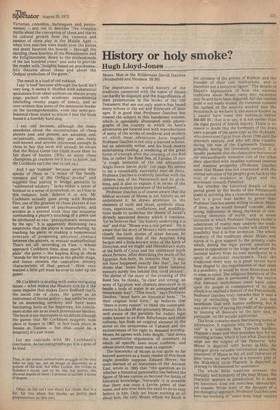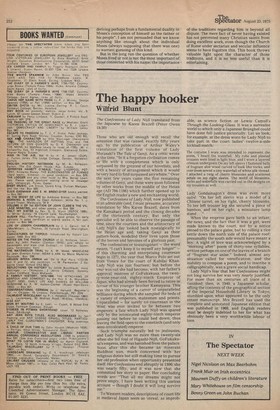History or holy smoke?
Hugh Lloyd-Jones
Moses: Man in the Wilderness David Daiches (Weidenfeld and Nicolson £6.50)
The importance in world history of the traditions connected with the name of Moses can hardly be disputed; and the magnificence of their presentation in the books of the Old Testament that are our only source has found many echoes in the art and literature of later ages. It is good that Professor Daiches has treated the subject in this handsome volume, which is splendidly illustrated with photographs of the country in which its hero's adventures are located and with reproductions of many of the works of medieval and modern art which these adventures have inspired. Professor Daiches is not only a learned scholar, but an admirable writer, and his book makes entertaining reading; a rendering of the great hymn of triumph after the crossing of the Red Sea, or rather the Reed Sea, at Exodus 15 into "a rough imitation of the old alliterative Anglo-Saxon heroic style" (on page 95) seems to me a remarkably successful tour de force. Professor Daiches is evidently familiar with the Hebrew text of the Pentateuch and its problems, and is able to explain it in terms of the extensive modern literature of the subject.
Professor Daiches is of course aware that the biblical account of Moses is not history as we understand it; he draws attention to the elements of myth and ritual, symbolic situations, repetitions, conflations and modifications made to underline the theme of Israel's divinely appointed destiny which it contains. Yet he believes that "the history underlying it is real" and that "Moses was a real person". He is aware that the story of Moses's birth resembles closely the birth stories of other heroes; he himself mentions that of the Assyrian king Sargon and a little-known story of the birth of Dionysus, and we might add Herodotus's story of the birth of Cyrus and the celebrated myth about Perseus. After describing the death of the Egyptian first-born, he remarks that "it may not have happened exactly like that", but he thinks that "some fierce and bitter national memory surely lies behind this vivid picture". The theme of the story of the crossing of the Reed Sea, he thinks, "is clear and strong: an army of Egyptian war chariots destroyed in or beside a body of water in an unexpected and remarkable way". "This much," says Professor Daiches, "must have an historical base." "In their original brief form," he believes that "there is every reason" to think the commandments in Exodus 20 are genuinely Mosaic. He is well aware of the parallels for Judaic legal codes known to us from Babylonian and other cultures, but finds an original element in the stress on the uniqueness of Yahweh and the exclusiveness of his right to demand worship. Moses, he agrees with John Bright, "laid down the constitutive stipulation of covenant to which all specific laws must conform, and whose intent they must seek to express."
The historicity of Moses is not quite so far beyond question as a hasty reader of this book might possibly suppose. Eduard Meyer, the most learned of all historians of the Ancient East, wrote in 1905 that "the question as to whether a historical personality lies behind the figure of Moses carries us beyond the limits of historical knowledge. Naturally it is possible that there was once a Levite priest of that name, and who ever feels the need to do so may believe in him. Only we know nothing at all about him; the only Moses whom we know is
the ancestor of the priests of Kadesh and the founder of their cult institutions, and is therefore not a historical figure." The details of Meyer's explanation of how the various traditions about Moses came into existence may be and have been disputed; but the central point is not easily eluded. By common consent the earliest of the sources worked into the Pentateuch as we have it, the source known as J, cannot have come into existence before 950-850 BC; that is to say, it is not earlier than the regal period of Jewish history. There is no reason to doubt that the forebears of the Jews 'were a people of the same type as the Hyksosn, who dominated Egypt from about 1700 until 'the sixteenth century; and who left that country during the rule of the Eighteenth Dynasty, probably during the thirteenth century. It is equally probable that the distinctive features of the extraordinarily intensive cult of the tribal deity identified with Israelite national interest and material prosperity (Professor Daiches notes that Moses was not concerned with the eternal salvation of his people) goes back to the time of the residence in Egypt and the .movement towards Palestine. But whether the historical details of that period given by the books of the Pentateuch stand in anything like a close relation to actual fact is a good deal harder to prove than Professor Daiches seems willing to allow. Many of them, as he would himself concede, show strong indications of being mythical or containing elements of myth; and in some instances in which Professor Daiches thinks a substratum of reality may underly the traditional story, the cautious reader will admit the possibility that it is free invention. The whole tendency of the traditions about Moses and Aaron is to give support to the priestly caste which, during the regal period, asserted its power in opposition to the kings and wrote the national history from its own standpoint in a spirit of sectional intolerance. That the traditional story may to a great extent have been shaped by the requirements of that caste is a possibility it would be most hazardous not to keep in mind. The religious literature of the regal period also is permeated by the notion that national misfortunes must have come upon the people in consequence of its sins, which is so marked a feature of the Pentateuch. Professor Daiches truly remarks that it was a way of reconciling the idea of a just and beneficent God with human suffering; but it was also a way of saving the credit of the priests by blaming all disasters on the laity and, in particular, on the secular authorities. The book contains many fascinating items of information. It explains why the form "Jehovah" is a solecism; how Yahweh hardens Pharaoh's heart and then punishes him for his resulting actions, which is just what Zeus does; what are the origins of the Passover; why Moses is depicted with horns (p.243), An epilogue gives valuable information about the treatment of Moses in the art and literature of later times; we learn that in a mystery play of the Wakefield cycle Pharaoh is depicted as praying to Mohammed for assistance.
The whole Bible tradition stresses the mortality and humanity of the man Moses. His character appears as paradoxical; he is meek yet ferocious, kind yet merciless, democratic yet remote. While wary of the dangers of a psychological approach, Professor Daiches sees here the working of "some deep inner tension deriving perhaps from a fundamental duality in Moses's conception of himself as the tather or his people". I am not persuaded that we know anything like enough about the individual Moses (always supposing that there was one) to warrant guessing of this kind.
But in the long run the question of whether Moses lived or not is not the most important of those connected with his name; the importance of the traditions regarding him is beyond all dispute. The mere fact of never having existed has not prevented many Christian saints from doing excellent work, even though the Church of Rome under sectarian and secular influence seems to have fogotten this. This book throws valuable light upon the character of those traditions, and it is no less useful than it is entertaining.



































 Previous page
Previous page